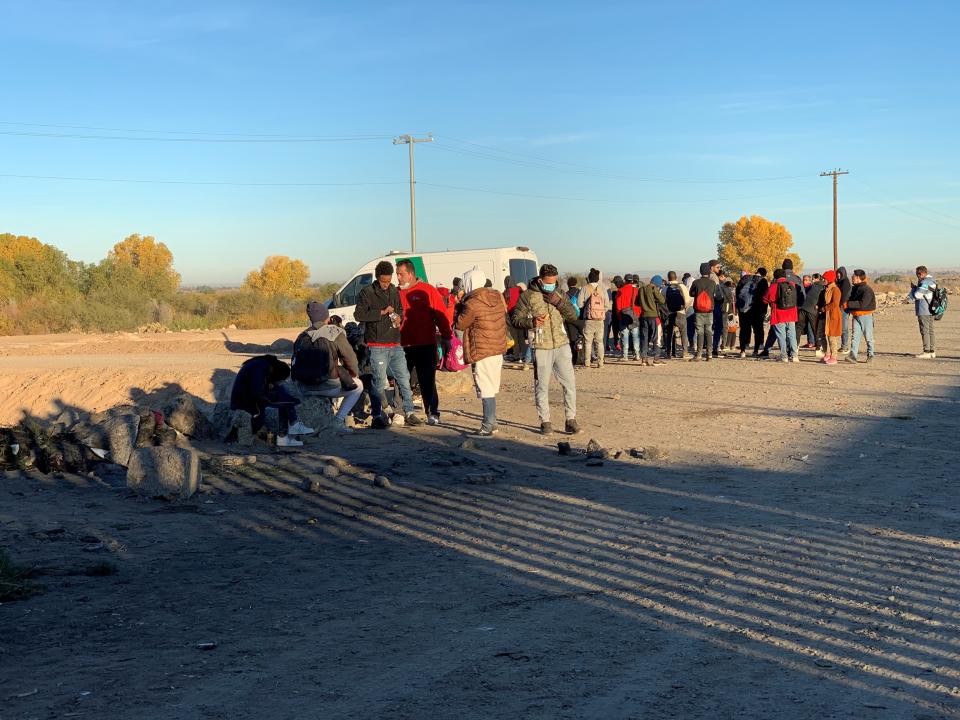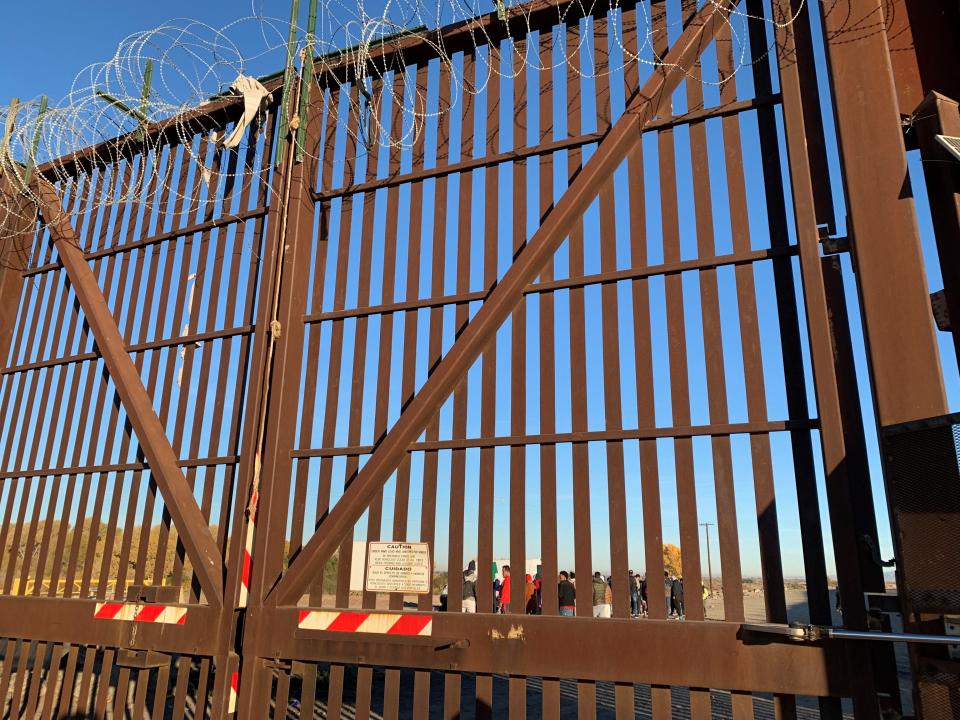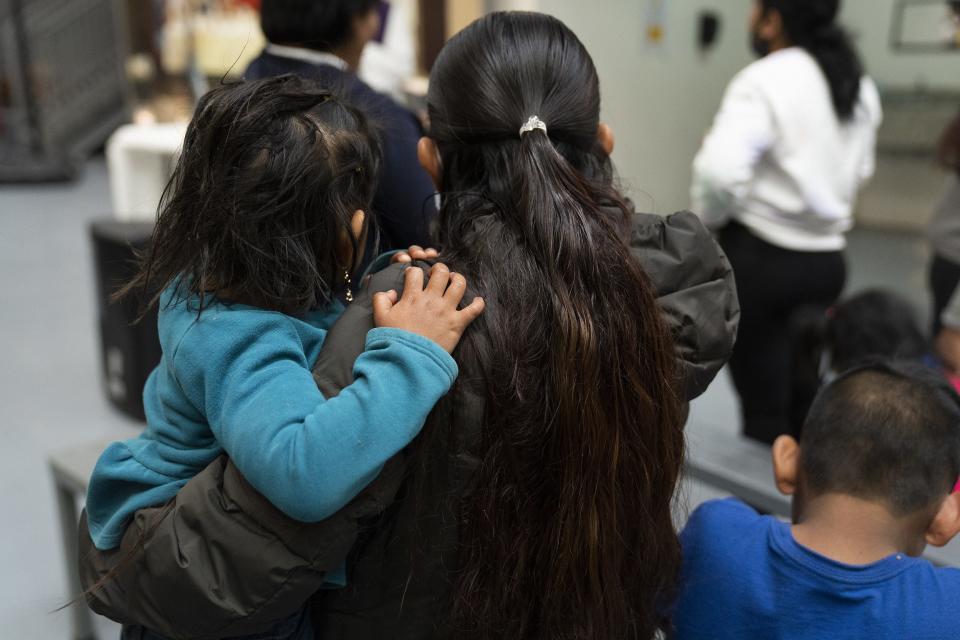Migrants from many countries are arriving at the US-Mexico border. Here's why
Encounters of migrants along the U.S.-Mexico border exceeded 2.3 million last year, an all-time high.
Two decades ago, when Border Patrol apprehensions also hit records, the vast majority of migrants who crossed the southern border illegally were adult males from Mexico seeking jobs in the U.S.
But the migrants arriving at the border today include not just men from Mexico, but also men, women and children, often entire families, from more than a dozen countries in the Western Hemisphere, notably Guatemala, Honduras, and El Salvador, and more recently, Cuba, Venezuela, Haiti, Nicaragua, Ecuador and Colombia.
Migrants also have been showing up at the southern border increasingly from countries on other continents, among them Russia, China, and India.

Instead of trying to evade the Border Patrol as in the past, many of the migrants arriving today turn themselves over to border agents as soon as they cross and request asylum on the grounds they are fleeing violence and persecution.
Why are so many migrants from so many countries arriving at the southern border? What has changed?
Republicans blame President Joe Biden's border policies, which they say have encouraged migrants to come to the U.S. and ask for asylum, putting their lives into the hands of cartels and criminal smuggling organizations, who profit off their desperation.
Biden's border policies have been more welcoming to asylum seekers than those of former President Donald Trump.

About 1 million asylum-seekers have been admitted under the Biden administration, the Migration Policy Institute and New York Times estimate. Mark Morgan, former acting commission of U.S. Customs and Border Protection under Trump, estimates 3 million to 4 million migrants, including unaccompanied minors, family members and people who evaded the Border Patrol are now living in the U.S. since Biden took office.
In an effort to stem migration, the Trump administration separated families at the southern border. The Trump administration also implemented an emergency public health rule called Title 42 at the start of the COVID-19 pandemic to quickly expel migrants to Mexico, including asylum seekers from other countries. The Biden administration kept the policy in place, but is now trying to end it.
Republicans are trying to force the Biden administration to keep Title 42, warning that ending the policy will trigger an even bigger influx of migrants and worsen the crisis. Title 42 remains in effect for now after the Supreme Court in January ordered the policy be kept in place until a final ruling on its legality.
Experts say focusing only on border policies such as Title 42 that attempt to restrict migration will fail to solve the border crisis. More attention needs to be put on addressing the reasons so many migrants from so many countries are choosing to leave their homes, they say.
"When Title 42 disappears, which it probably will eventually, there will be a border-management issue," said Eric Olson, policy director at the Seattle International Foundation, which promotes democracy in Central America. "But we have to look more long term at the drivers of migration."
What are the drivers prompting people to migrate? The reasons vary by country, Olson said. In general, there are several overall trends pushing people to leave, Olson said.

A rise in autocratic governments in several Latin American countries is one big factor, Olson said.
A case in point is Nicaragua, where mounting repression under leftist President Daniel Ortega and his wife, Vice President Rosario Murillo, has sparked an exodus of migration to the U.S., Olson said.
"In a lot of those countries, you see widespread government failure. Cuba (is crumbling). Haiti is crumbling. Venezuela has been crumbling for some time. Increasingly, Nicaragua, as well, they've lost credibility as a country where there is basic respect for human rights," Olson said.
An erosion of fragile democracies that has resulted from the rise in autocratic governments is another factor, Olson said. Growing corruption that stems from a decline in democracy is a third factor.
On top of that, the COVID-19 pandemic has exacerbated inequities in many parts of Latin America, and environmental disasters related to climate change are pushing people to migrate.
"The bottom line is that people are increasingly feeling helpless and pessimistic about their futures for a variety of reasons − government failure, insecurity, no economic possibilities or limited economic possibilities − and so that drives people to look for alternatives," Olson said. "What's most available to people is connections to family that are already living in the United States, and those networks of family migration have been building up for four decades."
Recent migration to the U.S. is grouped into three waves, said Ariel Ruiz, a policy analyst at the Migration Policy Institute.
The first wave from the 1980s through 2007, the start of the Great Recession, was made up mostly of migrants from Mexico, he said.

The second wave starting in 2014 was made up of a influx of unaccompanied minors and then families fleeing poverty, gang violence and high homicide rates in the Northern Triangle countries of Guatemala, El Salvador, and Honduras in Central America. Ninety-four percent of the migrants expelled under Title 42 have come from Mexico and Northern Triangle countries, CBP data shows.
The third wave starting in 2019 has been made up of migrants fleeing poverty, violence and increasingly political repression in other countries in the Western Hemisphere.
"It is migration from Cuba, Venezuela, Nicaragua, Haiti, Colombia, Peru and Ecuador. That is where we are at now," Ruiz said, noting that many of the migrants arriving from those countries are single adults.
Here are brief profiles of the countries where a majority of migrants arriving at the southern border have come from over the past three years. (Fiscal years 2020-2023. October, 2019 through December, 2022)
The list includes the total number of migrant encounters by U.S. border authorities for each country; the total number of migrants expelled under Title 42 for each country, and the total number placed in deportation proceedings under Title 8 of U.S. immigration laws for each country.
Migrants processed under Title 8 can include asylum seekers released in the U.S. pending the outcome of their cases in immigration courts, migrants held in detention centers awaiting possible deportation, and migrants who were later deported.
It's important to note that encounters by border authorities do not reflect the number of individual people who crossed the border illegally but the number of times a migrant from that country was encountered. That is because repeat crossers who cross illegally again after being expelled under Title 42 or other reasons are counted multiple times.
Brazil
Total encounters: 120,191.
Title 42: 7,368.
Title 8: 112,823.
Migrants from Brazil have been arriving at the border for decades but the number has risen sharply in recent years, CBP data shows.
"Rising crime, highly publicized corruption scandals, and growing political volatility," are among the main reasons, according to the Migration Policy Institute.
Brazil's political crisis has only worsened, which could spur more migrants to flee. Thousands of supporters of Brazil's former President Jair Bolsonaro, on Jan. 8 stormed the country's Congress, Supreme Court and presidential palace in an effort to restore the far-right politician to power or oust his newly inaugurated leftist rival, Luiz Inácio Lula da Silva, USA Today reported.

Colombia
Total encounters: 181,978.
Title 42: 16,921.
Title 8: 165,060.
Migrants from Colombia have significantly increased, CBP data shows, up from just 404 in fiscal year 2020 to more than 125,000 last fiscal year.
Colombia, at the northern coast of South America, has been mired by an armed conflict that has lasted for half a century and left more than 450,000 people dead, a June 2022 truth commission report said. Over that period, the U.S. has backed the Colombian government's battle against drug cartels.
In March, to counter the surge of migrants from Colombia arriving at the border, the Biden administration launched deportation flights to Colombia under Title 42, CBS News reported.
In November, Colombia's first leftist President Gustavo Petro asked the Biden administration to grant temporary legal status to Colombians who have come to the U.S. without papers, the Associated Press reported.
Cuba
Total encounters: 379,152.
Title 42: 16,828.
Title 8: 362,331.
There has been a steady flow of migrants from Cuba to the U.S. since the start of Fidel Castro's communist revolution in 1959. But the latest wave is the largest, and surpasses the first big wave from 1959 to 1962, according to the Migration Policy Institute.
Since October 2019, U.S. border authorities have encountered migrants from Cuba nearly 380,000 times. That is the fourth highest total from any one country during that period, according to an analysis of CBP data. The vast majority of those encounters, more than 327,000, have taken place in just the past 15 months. And nearly all of the Cubans who have arrived at the southern border, 95%, have been processed under Title 8, meaning they have been allowed into the U.S. instead of expelled.
Several factors are fueling the historic wave of Cubans fleeing to the United States, said Jorge Duany director of the Cuban Research Institute at Florida International University.
Cuba has experienced the worst economic crisis to hit the communist country since the collapse of the Soviet Union in the early 1990s. The COVID-19 pandemic, which devastated the tourism industry, dried up remittances, and further worsened the economy, Duany said.
Arrests and imprisonment of political dissidents in the wake of the July 2021 protests against the Cuban government has also fueled the mass exodus, Duany said. The tightening and addition of sanctions under the Trump administration as part of the decades-long U.S. embargo of Cuba has also worsened conditions on the island, and prompted people to leave, Duany said.
The Cuban government is using migration as an "escape value" by exporting dissidents and people who can't find work, and to pressure the U.S. for better relations with Cuba, Duany said.
To stem the surge of Cubans arriving at the southern border, the Biden administration announced Jan. 5 that up to 30,000 Cubans, Haitians and Nicaraguans per month will be expelled to Mexico if they enter the U.S. illegally, while some Cubans who qualify will be allowed to enter legally through humanitarian parole.
Ecuador
Total encounters: 167,364.
Title 42: 60,864.
Title 8: 106,500.
The number of migrants from Ecuador encountered at the southern border skyrocketed to more than 96,000 in fiscal year 2021, but fell last year to 24,000. Encounters of migrants from Ecuador are on the rise again, jumping to over 35,000 during October, November, and December, CBP data shows.
Blanca Ninasunta, a 21-year-old indigenous woman from Ecuador, told The Arizona Republic in December she made the 2,500-mile month long journey with husband, William Cofre, 24, and their 2-year-old daughter, to escape crushing poverty in Ecuador. To reach the U.S. border, they traveled through seven countries including Mexico, and walked for two days through the snake-infested jungle of a nearly impassable roadless wilderness called the Darien Gap that separates Central and South America.
El Salvador
Total encounters: 229,283.
Title 42: 127,273.
Title 8: 102,010.
Gangs and criminal violence are some of the main reasons migrants have fled El Salvador, including large numbers of unaccompanied minors and parents traveling with children. MS-13 and Barrio 18, two of the most infamous gangs, stem from members of Los Angeles street gangs deported to El Salvador in the 1990s, when the country was still recovering from a 12-year civil war between the U.S-backed Salvadoran government and the leftist FMLN.
El Salvador's murder rate, once among the highest in the world, has fallen sharply in recent years amid a crackdown on gangs by El Salvador's authoritarian President Nayib Bukele.
Other factors driving migrants to flew El Salvador are poverty, inequality, and environmental disasters such as hurricanes, floods and droughts related to climate-change, according to The World Bank.
Guatemala
Total encounters: 606,729.
Title 42: 368,275.
Title 8: 238,454.
Migrants from Guatemala account for the third-highest number of encounters along the southern border, behind Mexico and Honduras. The exodus from Guatemala to the U.S. has been caused by many factors, including high rates of poverty, inequality, violence and widespread corruption in Guatemala, a country in Central America that together with El Salvador and Honduras comprise a region known as the Northern Triangle.
Under Guatemala's President Alejandro Giammattei, anti-corruption prosecutors have faced attacks, and the president himself has faced numerous allegations of corruption, leaving Guatemala's "democracy hanging by a thread," according to a February 2022, Americas Quarterly report.
"For years, Guatemala’s leaders have undermined the rule of law and democracy in an apparent effort to avoid accountability for widespread high-level corruption," the report said.
Many of the migrants from Guatemala come from Huehuetenango and other departments in the Western Highlands, a region of mainly indigenous communities, according to the Migration Policy Institute.
Most are escaping high rates of poverty. "This contrasts with El Salvador and Honduras, where people are more likely to indicate violence as a major motivator for migrating," according to a March 2022 MPI report. Some farmers in the Western Highlands have replaced corn and other crops with poppy under pressure from drug cartels who turn sap from the pants into heroin.
New rules: Biden expands Title 42 under new rules; app required to claim asylum at border
Eighty percent of children under the age of five in Guatemala's Western Highlands suffer from malnutrition, among the highest percentages in the America's, said Olson at the Seattle International Foundation.
In 2018, the Trump administration implemented a "zero tolerance" policy intended to discourage families from Mexico and Central America to travel to the U.S. seeking asylum. Under the policy, more than 3,900 children were separated from parents at the border, and many of those children were from Guatemala. In many cases, parents were deported, while their children remained in shelters in the U.S.
Under Title 42, 61% of Guatemalan migrants have been expelled to Mexico, the highest share of any nationality, except migrants from Mexico, according to CBP data.
Haiti
Total encounters: 123,027.
Title 42: 24,094.
Title 8: 99,933.
Many of the Haitian migrants arriving at the U.S. southern border are fleeing a political crisis that continues to spiral downward. Haiti's president, Jovenel Moïse, was assassinated in July 2021 and the country is being run by what some call "a de facto dictatorship nominally in charge of a country wracked by gang violence," according to the Associated Press.
The small impoverished Caribbean country of 11 million, located on the island of Hispaniola it shares with the Dominican Republic, has also been plagued by natural and environmental disasters. A magnitude-7.2, earthquake struck the country in August, 2021, followed days later by a major tropical storm, causing many Haitians to flee.
Images of Border Patrol agents on horseback with whips repelling Haitian families amassed along the banks of the Rio Grande in Del Rio, Texas drew outrage in September 2021.
Many Haitian migrants arriving at the border are not coming directly from Haiti but from Brazil and other countries in Latin America, where they have been living for years after fleeing earlier political upheaval and natural disasters, according to the Migration Policy Institute. The country's devastating 2010 earthquake killed more than 217,000 people and left more than 1.5 million people homeless.
To slow the flow of Haitians coming to the U.S., the Biden administration announced Jan. 5 that Haitians, Cubans and Nicaraguans will be quickly expelled to Mexico under Title 42 if they cross the southern border illegally, drawing criticism from advocates. Meanwhile, some Haitians, Cubans and Nicaraguans with relatives or sponsors in the U.S. will will be allowed to enter legally through humanitarian parole.
Honduras
Total encounters: 614,151.
Title 42: 337,956.
Title 8: 276,195.
Other than Mexico, the largest number of migrants arriving at the southern border have come from Honduras. Many migrants from Honduras travel through Mexico in large caravans made sometimes of thousands of people traveling together on foot, by car, on flatbed trucks and on top of freight trains.
Many are fleeing crime, insecurity, poverty, and deeply-embedded corruption. Thousands of Hondurans fled the country in caravans in 2018 following a bloody crackdown on street protests calling into question the 2017 election of former Honduran President Juan Orlando Hernandez. In November 2019, the president's brother, Tony Hernandez, was arrested in Miami and charged with smuggling tons of cocaine from Honduras into the U.S. among other charges. He was later found guilty and sentenced to life in prison. In April, the former president was extradited to the U.S. Federal prosecutors accuse Hernandez of operating Honduras as a "narco-state" and with partnering with cartels to traffic hundreds of thousands of kilograms of cocaine through Honduras for distribution in the U.S. Honduras has also been plagued by catastrophic environmental disasters, including back-to-back tropical storms in November 2020.
What is Title 42 and is it ending? The US border immigration policy, explained
More than half of the 614,000 migrants from Honduras encountered at the southern border have been expelled to Mexico under Title 42, the highest share behind Guatemala and Mexico.
Mexico
Total encounters: 1,934,819.
Title 42: 1,569,343.
Title 8: 383,475.
Mexico, which shares a nearly 2,000-mile border with the United States, remains the main source of unauthorized migration to the U.S. Of the 5.3 million migrants encountered at the southern border since October 2019, about 36% were from Mexico.
Higher-paying jobs and better economic opportunities remain the main reasons migrants from Mexico come to the U.S. Migration from Mexico to the U.S. declined in the past decade in the wake of the Great Recession, when jobs in construction, the hospitality and other industries dried up, and economic conditions improved in Mexico.
But migration from Mexico is rising again. The recent surge is due to worsening economic conditions and an increase in violence, said Ariel Ruiz, a policy analyst at the Migration Policy Institute.
A growing number of migrants from Mexico arriving at the border are seeking asylum and are from states with high rates of drug cartel violence, including Guerrero and Michoacan.
Nicaragua
Total encounters: 306,794.
Title 42: 7,999.
Title 8: 298,795.
There has been a huge spike over the past few years in the number of migrants arriving at the border from Nicaragua, a country of 6.3 million people located in Central America. In fiscal year 2020, border authorities logged just 2,291 encounters with migrants from Nicaragua. Last year, the number of encounters with Nicaraguan migrants soared to nearly 164,000. And during just the first three months of fiscal year 2023, there have been more than 90,000 encounters with Nicaraguan migrants, according to CBP data.
Nicaragua is the second poorest country in the Western Hemisphere, behind Haiti.
Migration from Nicaragua to the U.S. is being fueled by "soaring inflation, declining wages and the erosion of democracy under an increasingly authoritarian government," according to the New York Times.

The U.S. has a strained relationship with Nicaragua's leftist Sandinista government, headed by President Daniel Ortega, and his wife, Vice President Rosario Murillo.
"Nicaragua’s current leaders have systematically undermined Nicaragua’s democratic structures — including separation of powers, the electoral system, and respect for human rights — resulting in the concentration of power in the hands of two individuals: President Daniel Ortega and his wife, Vice President Rosario Murillo," according to a September 2022 statement by the U.S. State Department.
On Jan. 5, the Biden administration announced that migrants from Nicaragua who arrived at the border without authorization would be expelled quickly to Mexico under Title 42, along with those from Haiti and Cuba. Some asylum seekers from Nicaragua will be allowed to enter the U.S. through humanitarian parole if they have sponsors in the U.S.
Peru
Total encounters: 83,310.
Title 42: 2,065.
Title 8: 81,245.
Migration from Peru to the U.S. is a recent phenomenon. Nearly 80,000 migrants from Peru have arrived at the southern border since October 2021, compared to just 3,681 from Peru the previous 24 months, according to CBP data.
Soaring inflation, crime, widespread corruption and political turmoil have all contributed to an exodus of migrants from Peru to the U.S., Peruvian activist Andres Urbano told the New York Post. The exodus could rise even more as the country's political situation continues to deteriorate.
Violent demonstrations following the ouster of former President Pedro Castillo in December have resulted in at least 47 deaths, the Associated Press reported.
Russia
Total encounters: 43,634.
Title 42: 266.
Title 8: 43,368.
The number of migrants from Russia arriving at the southern border spiked from 4,100 in fiscal year 2021 to nearly 22,000 last year. Another 17,000 Russian migrants were encountered during just October, November and December. Many are military-age men who escaped Russian President Vladimir Putin's mobilization orders to fight in Ukraine, the New York Post reported.
Unlike asylum seekers from other countries who have been released pending the outcome of their cases in immigration courts, many asylum seekers from Russia are being held in detention facilities, the New York Times reported.
Ukraine
Total: 26,197.
Title 42: 185.
Title 8: 26,012.
Thousands of migrants from Ukraine began arriving at the southern border after Russian launched a military invasion of the Eastern European nation at the end of February, 2022 and triggered a mass exodus of people.
Most of the Ukrainians who traveled through Mexico arrived in Tijuana, south of San Diego. Ukrainians who arrived at the southern border were initially allowed to enter the U.S. to seek asylum.
But at the end of April, the Biden administration announced that Ukrainians who arrived at the southern border without a valid visa or pre-authorization would not be allowed to enter the U.S. and directed to apply for the new Uniting for Ukraine program. The Biden administration has committed to allow up to 100,000 Ukrainians fleeing armed conflict to come to the United States under the program.
Venezuela
Total encounters: 277,287.
Title 42: 18,536.
Title 8: 258,751.
Venezuela is on the northern coast of South America. Under populist President Nicolas Maduro, Venezuela "has been in the grips of an economic, political and humanitarian crisis since 2014, as a government claiming socialist ideals has gutted the country’s democratic institutions and left much of the populace impoverished," according to the New York Times.
More than 7 million migrants, about a quarter of the population, have fled Venezuela since 2015, according to the International Monetary Fund, making it the largest exodus of people in the Western Hemisphere in recent times. Most migrants from Venezuela have fled to other countries in Latin America, but the United States has experienced a big spike in migrants from Venezuela. Venezuelan migrants were encountered at the southern border nearly 188,000 times in fiscal year 2022, up from about 50,000 the previous year.
In October, the Biden administration began expelling to Mexico Venezuelan migrants who crossed the border illegally under Title 42, while allowing up to 24,000 asylum seekers from Venezuelans to enter the U.S. through humanitarian parole, provided they have a sponsor and travel by air.
Reach the reporter at daniel.gonzalez@arizonarepublic.com or at 602-444-8312. Follow him on Twitter @azdangonzalez.
This article originally appeared on USA TODAY: Migrants from many countries are arriving at the US-Mexico border

 Yahoo Movies
Yahoo Movies 